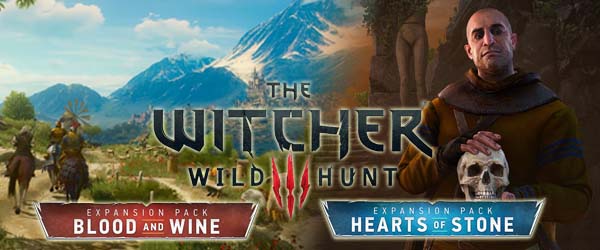
I just don't understand how CD Projekt Red can be such masters at world building and quest design, but are completely inept at everything that involves Geralt drawing a sword or throwing igni. I almost gave up on Hearts of Stone because the beginning of its main quest just put me into a controller-throwing rage.
Geralt is tasked with killing a mysterious sewer monster who has been killing women who go into the sewer hoping to find a toad who can be turned into a prince with a kiss. One of The Witcher III's long-standing annoyances for me is that it makes such a big deal about Geralt being so analytical that he prepares for every monster hunt with potions and so forth, but whenever a quest boss comes along, the game decides to just throw the player in with no chance to prepare. This quest provided no opportunity to investigate to learn what the toad monster is or what its weaknesses might be. When you hit an arbitrary point in the sewer, the game triggers a cutscene that just throws Geralt into the boss arena, so you can't re-equip yourself, respec, or otherwise prepare.
To make matters worse, the game checkpoints you inside the boss fight, instead of prior to the cutscene. If you die, you have to wait for the game's god-damned-bloody long-ass load times before having to go through the trouble of resetting your equipped potions or any other preparatory activities, only to survive for thirty seconds before the fracking toad kills you again and you have to sit through another two minutes of load screen before having to start it all over again. Just unacceptable, CD Projekt Red; absolutely unacceptable.
In order to beat the damn thing, I had to reload from an autosave earlier in the quest (fortunately, I didn't lose much progress) and use the Potion of Clearance to respec Geralt to take points out of my [currently useless] support skills and put them into abilities that buffed my attack, defense, and the two spells that are actually useful for this fight.
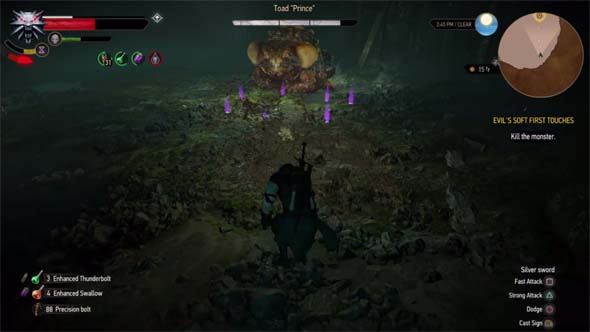
The boss fights in Hearts of Stone seem to break the game's rules, and frustrated me to no end.
To add insult to injury, this boss fight ends with a cutscene, and the next playable, non-dialogue sequence is another boss fight, this time a mage with an entourage of soldiers. Without any of my support or crowd-control spells, I ended up having to replay this fight several times as well (it didn't help that the mage seemed to have a one-hit kill area-of-effect tornado attack). At the end, I thought I would be able to respec my character back to the way I had him, but apparently that potion is only a one-time use. I had to fast travel around to several merchants to try to find someone who would sell another copy to me (because Kiera disappears after you finish the main story, so I couldn't buy it from her). It cost 1,000 gold! Then, after finding my way back to the original quest-giver, I got stuck in yet another obnoxious boss fight.
All three of these boss fights seemed to break the game's established rules. The first one kept hitting me with poison, so I tried using a potion that was supposed to allow me to heal from exposure to poison. Except the potion didn't work. Neither of the other two bosses were vulnerable to Yrden or to dimeritium bombs to block or negate their magic abilities. This all was incredibly frustrating, as one of my biggest pet peeves with video games is when the developers give bosses immunity to all the fancy support items and spells that the player has, which you've been saving up for just such an occasion - a boss being the one place where such tools are actually useful or necessary. On top of that, all three fights are needlessly long endurance matches that quickly devolve to repeating the same few actions a hundred times in a row. Absolutely, unforgivably terrible boss fights, the whole lot of them! Needless to say, this DLC did not get off on the right foot with me - much like the base game didn't.
But I grit my teeth and played through the base game, only to find some of the most outstanding quest design and characters that gaming has to offer. So I would do the same with the Hearts of Stone DLC. And once again, I was rewarded for my patience with a quality storyline.... [More]
785a1852-4d97-42a1-8809-18dc15cc467f|0|.0
Tags:The Witcher, The Witcher III: Wild Hunt, expansion, DLC, Hearts of Stone, Blood and Wine, CD Projekt Red, Geralt, open world, RPG, Olgierd von Everec, Iris von Everec, Gaunter O'Dimm, Toussaint, Beauclaire, vampire, homestead, estate, vineyard, immortality, predestination, France
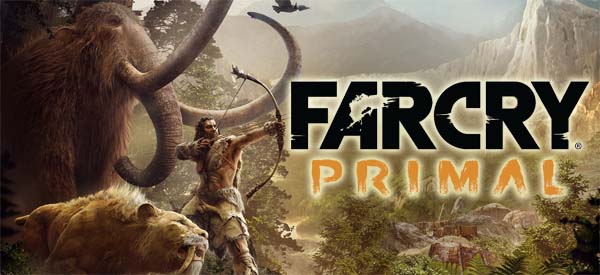
I've never played any of the Far Cry games. I possess a copy of Far Cry 4 because it came bundled for free with my PS4, but I've yet to actually insert the disc into the console and try the thing. I was intrigued by Far Cry Primal because it looked like it might explore a novel subject matter that games have kind of ignored for as long as I can remember. Apparently, Far Cry 4 had a bit in it in which you play as a primitive human riding around on animals during a drug-fueled hallucination, and Ubisoft decided to adapt that concept into a full game.
The last time that Ubisoft had done something like this, they had taken the naval combat from Assassin's Creed III (the completely dissociated highlight of an otherwise boring and stupid game) and converted it into Assassin's Creed IV: Black Flag. And I loved Black Flag! So I was optimistic that Ubisoft might have another novel treat in store for me. I've played dozens of first person shooters, but I've yet to play as a caveman in 10,000 BCE, so let's give this a go, shall we!
The game begins by showing the date 2016, with modern ambient sounds, apparently intended to make the player think that the game might have some kind of present-day framing device (similar to Assassin's Creed). But then the clock starts ticking back to 10,000 BCE, and the game begins. I wonder if this was intended to mock Assassin's Creed and subvert possible player expectations.
Stone age shooter
This game got off to kind of a rough start for me. I was killed by the mammoth in the tutorial because it charged at me before the game displayed the tutorial tip teaching how to attack with a weapon. So that seemed like a cheap death, and gave me a bad first impression. Fortunately, the next few hours of play didn't have any similarly sloppy design, and I was rather enjoying myself.
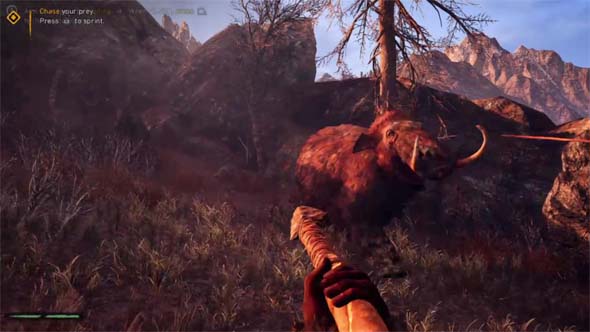
I died in the tutorial because the mammoth charged me before the game taught me how to use my weapon.
It didn't take long, however, for the novelty to wear off. Combat has a focus on melee combat with clubs and spears, which leads to a problem similar to other first-person hack-n-slash games: the constrained field of view makes situational awareness very difficult. Without the option to toggle to a third-person view, it's difficult to tell exactly what is going on immediately around your character, and close-quarters combat with mobs frequently degraded into just spinning around mashing the attack button. Fighting animals can be even worse, as many of them (such as dholes and badgers) are small and fast and incredibly difficult to actually hit. The problem is mitigated somewhat as the game goes on, as new utility abilities are introduced, but I was saddened that Ubisoft didn't really do anything particularly interesting with the basic combat.
And it doesn't really get much better when the utility abilities are introduced, as they mostly just involve simply sicking your tamed beasts on the enemies and hoping that the beast doesn't die. In the regular gameplay mode, you'll also have access to overpowered one-hit kill attacks and bombing runs with your owl that act similarly to an air strike or artillery bombardment in other games. These attacks are so overpowered that the Survival Mode disables them entirely. If you have a powerful enough wolf, bear, or saber-tooth tiger beast, you can often just get away with commanding it to charge a group of enemies while you sit back and watch.
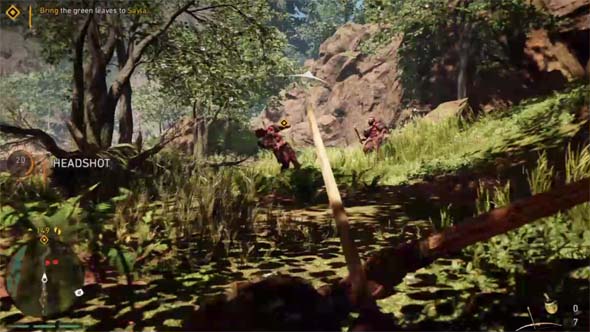
This is one game in which a bow and arrow actually makes sense as a primary weapon. [More]
f789f1b9-8096-44f0-a9aa-91493a4c83b7|0|.0
Tags:Far Cry, Far Cry: Primal, Ubisoft, prehistory, caveman, mammoth, wolf, bear, saber-tooth tiger, owl, beast, beast master, bow and arrow, spear, club, crafting, survival, open world, Darwin Award, Achievement unlocked
My past two blog posts have been focused on open world gaming. These posts have been continuations of an earlier post about the narrative "limbo" that many open world games create via their quest structures. In the first post in this second series, I pointed out what I perceive to be a problem with open world games that insist on turning their sandbox worlds into little more than convoluted mission-select screens and collectible checklists. In the following post, I described some games that I think managed to make successful open worlds by including features or mechanics that made traveling through the space (or knowledge of the space) into a meaningful mechanic. This time, I want to go back to some of the games that I singled-out in the first post in this series, and brainstorm some ways that they could have made better use of the large spaces that their maps offered so that traveling around the world wouldn't become so boring later in the game.
But before I do that, I want to re-emphasize that I don't hate these games. They're just not very good at using their space, and that's what I'm criticizing. Well, the newer Assassin's Creed games have been pretty terrible. Anyway, I pick on games like Skyrim and The Witcher III a lot, but I like them just fine - I bought the DLC for both. I pick on them, not because I hate them, but because I do like them and I want them to get better (or for their sequels to get better). Rather, my objective here is to find ways for these games to make better use of the large, open spaces that they provide the player, so that exploring the map feels more mechanically relevant, more interesting, or more rewarding; and to feel less like a time-sink.
Games like Skyrim and The Witcher III have massive worlds, but do a poor job of utilizing the space.
Bethesda's Skyrim and Fallout titles, as well as CD Projeckt Red's Witcher III and Rockstar's Grand Theft Auto V, already have open worlds that transcend being simple, convoluted mission-select screens like games like Assassin's Creed and Metal Gear Solid V. They populate their worlds with little narrative world-building details that make their worlds feel alive and lived-in (even though they may feel stagnant). So what could a game like Skyrim or The Witcher III have done to improve its open world? [More]
1a284324-86e6-4bf6-90a4-dca665c348d9|1|5.0
Tags:open world, sandbox, game design, road trip, map, traversal, travel, cartography, geography, narrative, ludonarrative, ludonarrative dissonance, limbo, paradox, Kafkaesque, quest, Ubisoft, Bethesda, Rockstar Games, Beenox, Insomniac Games, Naughty Dog, Assassin's Creed, The Elder Scrolls, Skyrim, The Witcher 3, Grand Theft Auto, Grand Theft Auto V, The Last of Us, Spider-Man, web-swinging, comic book
Last time, I discussed what I perceive as a problem in the way that most open world games (specifically, sandbox games) design their maps and use the space that the maps offer - or fail to use that space, to be more specific. So many open world maps end up feeling less like actually playing the game, and more like a convoluted mission-select and collectible checklist screens. This problem is especially bad in the Ubisoft model of design, and is also a problem (to a lesser extent) in Bethesda's open worlds. Due to the popularity of these developers' franchises, many other developers have been cloning these styles of games to one extent or the other, to the point at which Ubisoft's open world model seems to be the go-to template for any developer trying to make an open world game. These games aren't necessarily bad. They just aren't very good at making the space of their maps feel meaningful in its own right.
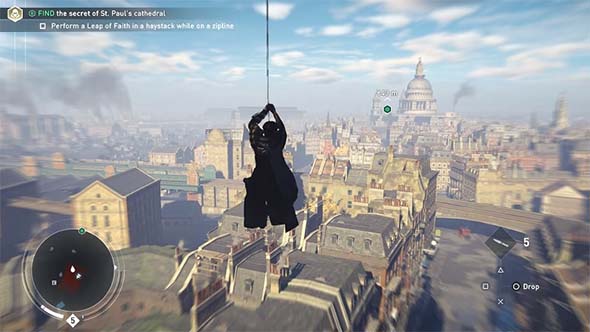
Many open world games have large, expansive maps that mostly feel empty and pointless,
as the player rushes through them simply to get to the next map marker or checklist item.
But now that I've established what I see as a problem, I want to focus on positive feedback. In this discussion, I'm going to look at a handful of games that should serve as inspirations for would-be open world developers. Ironically, some of these games aren't even open world games, but they still pose valuable lessons for how games that are open world could better use their game spaces. That isn't to say that the games discussed here are perfect. In fact, many of them have their own major flaws. But each of them has some element of design that utilizes the actual game map as a component of active play, rather than just a space in which game sequences exist. First, let's take a look at a game that was re-made recently, and use it as a "before and after" case study of map design... [More]
75d0658b-0278-43f3-a9e5-d3df3d01939d|4|4.3
Tags:open world, map, traversal, travel, cartography, geography, narrative, ludonarrative, ludonarrative dissonance, quest, vehicle, driving, racing, exploration, wasteland, survival, resources, Ubisoft, Bethesda, Resident Evil, Metal Gear Solid V: the Phantom Pain, Assassin's Creed, The Elder Scrolls, Skyrim, The Witcher 3, Grand Theft Auto, Grand Theft Auto V, Grand Theft Auto: San Andreas, Shadow of Mordor, Fallout, Fallout: New Vegas, Wasteland 2, Mad Max, Miasmata, Assassin's Creed IV: Black Flag, Burnout: Paradise, Shadow of the Colossus, Dark Souls
I wrote a lengthy blog late last year about the stagnant, "limbo"-like feel of most open world games' narratives. I had written that blog mostly before I played Metal Gear Solid V, and so I wasn't able to incorporate my thoughts regarding that game into the blog. But I did come to a new realization about open world gaming while I was playing MGSV. In my review of that game, I noted that:
"Even the open world itself feels constrained, as sheer cliffs prevent you from travelling too far off of the roads and serve to functionally railroad the player towards the small set-piece outposts and villages."
- from my Metal Gear Solid V: the Phantom Pain review
I realized while playing MGSV that the game had built this large, open world (well, two large, open worlds really, but I hadn't gotten that far yet), but it didn't really care to let the player actually traverse that space or use it in any meaningful way other than scavenger hunting for collectibles. At least those collectibles felt relevant to gameplay though! Roughly half the map is dead space that the player can't even access. There was also this strange focus on using the helicopter to drop in and drop out of missions, rather than actually living in the game world, as the character had to do in Snake Eater. The map started to feel less and less like a place, and more like a convoluted mission-select screen. At first, this seemed like a strange, isolated example of an open world game that really doesn't want the player actually exploring its world. But as I thought about it, I realized that this isn't really a new phenomenon; it's actually just a very extreme example of what has become a sort of defacto state in most open world games.
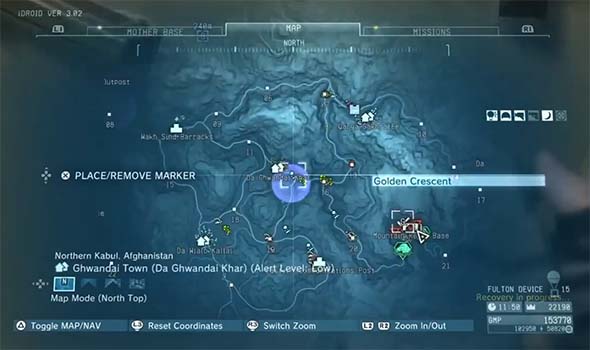
The Afghanistan map of Metal Gear Solid V feels heavily constrained by sheer cliffs.
Think about it this way: in a linear game with rooms and corridors, every hallway and room should serve some purpose or function. In most games, this function will be some kind of skill or system mastery test. An action game like Devil May Cry will throw enemies at you to fight; a puzzle game like Portal will have a puzzle (or a piece of a puzzle) in the room to solve; a stealth game like Metal Gear Solid 3 will have a sneaking challenge or obstacle to pass; and so on. In the best games, each of these challenges will also provide a unique or novel test of skill or system mastery: unique combinations of enemies, unique puzzles, or novel arrangements of enemies and obstacles. Other games can use those rooms for thematic or narrative purposes. A survival horror game like Resident Evil or Silent Hill will usually put enemies, puzzle items, or supplies in a room, but some rooms might instead contain a scripted scare. In some cases, a room might even be left completely empty in order to build some kind of tension or anticipation, or to delay the release of already-built tension or anticipation.
So what is the gameplay purpose of an open world map? ... [More]
d6e62cdb-b171-437a-b1a7-107859c9c818|4|4.5
Tags:open world, sandbox, game design, map, paradox, traversal, travel, cartography, geography, narrative, ludonarrative, ludonarrative dissonance, quest, exploration, driving, racing, vehicle, Ubisoft, Bethesda, Beenox, Metal Gear Solid V: the Phantom Pain, Assassin's Creed, the Amazing Spider-Man, Spider-Man, web-swinging, The Elder Scrolls, Skyrim, The Witcher 3, Fallout, Mad Max, Far Cry
|

| 12 | | | | | | | 60 | | 11 | | | | | | | 55 | | 10 | | | | | | | 50 | | 09 | | | | | | | 45 | | 08 | | | | | | | 40 | | 07 | | | | | | | 35 | | 06 | | | | | | | 30 | | 05 | | | | | | | 25 | | 04 | | | | | | | 20 | | 03 | | | | | | | 15 | | 02 | | | | | | | 10 | | 01 | | | | | | | 05 |
|